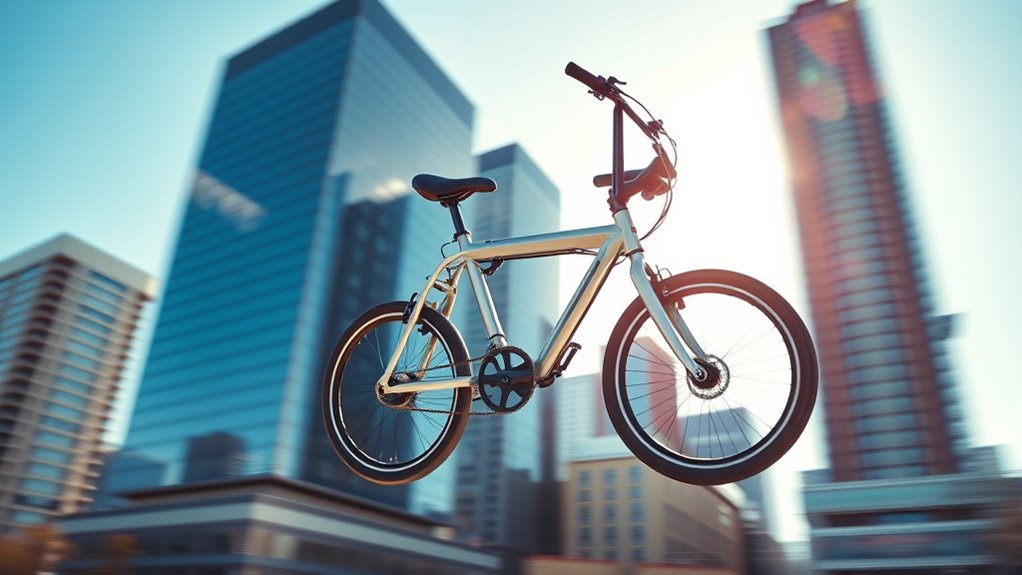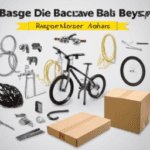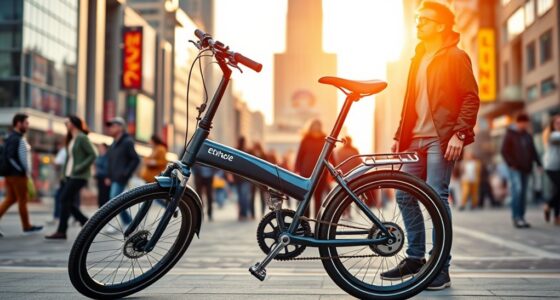Flying with a folding bike is convenient since you can carry it onto planes and explore easily upon arrival. Make sure to check your airline’s specific policies and size restrictions for bikes, as some may charge extra or require check-in. Pack your bike securely in a padded bag or hard case to avoid damage, and arrive early to handle any paperwork. With proper prep, traveling with your folding bike becomes simple—keep going to discover more tips!
Key Takeaways
- Check airline policies for carrying or checking a folding bike, including size and weight restrictions.
- Pack the bike securely in a padded bag or hard case to prevent damage during transit.
- Arrive early at the airport to handle documentation, screening, and potential additional fees.
- Ensure the folded bike meets airline size requirements; carry necessary proof of ownership if needed.
- Use your folding bike for easy exploration upon arrival, enhancing your travel experience.

Traveling with a folding bike makes exploring new cities easier and more convenient. The compact design of these bikes means you can carry them onto buses, trains, and, most importantly, onto airplanes. When considering bike portability, folding bikes stand out because they can be folded into a small, manageable size that fits easily into overhead compartments or under seats. This portability saves you from the hassle of checking in bulky bicycles, which can be time-consuming and costly. Instead, you can bring your bike along as carry-on luggage or in a specially designed travel bag, giving you more freedom to explore once you arrive.
Travel easily with a folding bike—compact, portable, perfect for airports, trains, and buses.
However, before you pack your folding bike for a flight, it’s essential to familiarize yourself with airline policies. Each airline has its own set of rules regarding the transportation of bicycles, especially folding models. Some airlines treat folding bikes as regular carry-on items if they meet size restrictions, while others require you to check them in as luggage. It’s a good idea to review the airline’s baggage policies well in advance to avoid surprises at the airport. Many airlines specify maximum dimensions and weight limits for carry-on or checked baggage, so measure your bike once folded and compare it to these guidelines. Some airlines may charge additional fees for checking in bicycles, even folding ones, so confirming costs beforehand can save you from unexpected expenses.
Packing your folding bike properly is crucial to ensure it arrives in good condition. Use a padded travel bag or hard case designed for bikes to protect it during transit. Make sure the bike is thoroughly cleaned before packing to prevent dirt from spreading inside the aircraft. Remove pedals, quick-release wheels, or any loose parts that could get damaged or cause damage during handling. Folding bikes are generally lightweight, but packing them securely helps prevent any issues during loading and unloading. Additionally, considering the high portability of these bikes can make your travel experience even more seamless.
When you get to the airport, arrive early to handle any paperwork or additional screening required for your bike. Having all your documentation, such as proof of bike ownership or airline approval, can streamline the process. Once onboard or checked, your bike remains a portable, flexible way to get around once you land, making your travel experience smoother and more enjoyable. With a little preparation and understanding of airline policies, flying with a folding bike becomes an easy, practical way to combine transportation modes, making sure you’re ready to hit the ground running in your next destination.
Frequently Asked Questions
Are Folding Bikes Allowed as Carry-On Luggage on All Airlines?
Folding bikes are not permitted as carry-on luggage on all airlines because of varying airline policies and folding bike restrictions. You should verify your airline’s policies beforehand, as some airlines permit folding bikes in the cabin if they meet size limits, while others require them to be checked. Always confirm the specific guidelines to avoid surprises at the airport and ensure a smooth travel experience with your folding bike.
What Are the Best Security Measures for Folding Bikes During Travel?
Your folding bike is your prized treasure, so don’t leave it unprotected! Use a sturdy bike lock to secure it to immovable objects and choose theft prevention measures like tamper-proof locks or security cables. Always keep a close eye on it, especially in crowded areas. These steps create an impenetrable barrier, making theft nearly impossible and ensuring your bike stays safe during your travels.
How Do I Pack a Folding Bike for International Flights?
To pack your folding bike for international flights, start by disassembling it according to the manufacturer’s bike storage instructions. Use bubble wrap or foam padding to protect delicate parts. Place it in a sturdy, appropriately-sized bike box or travel case. Follow packing tips like removing pedals, deflating tires, and securing loose components. Make sure your bike is well-cushioned and clearly labeled to guarantee safe handling during travel.
Are There Size Restrictions for Folding Bikes on Public Transportation?
You might worry about size restrictions for folding bikes on public transportation, but most transit systems have flexible storage regulations. Typically, bike size limits are designed to accommodate folded bikes, which usually fit in standard racks or storage areas. As long as your folding bike complies with these size limits, you can easily bring it on trains, buses, or subways. Always check local transit policies to guarantee smooth travel with your bike.
How Do I Maintain and Repair a Folding Bike While Traveling?
To maintain and repair your folding bike while traveling, start with regular bike cleaning to keep components in top shape. Carry essential tools like tire levers and a mini pump for tire maintenance, and learn simple fixes like adjusting the brakes or gear cables. Keep spare parts handy, and familiarize yourself with basic repairs before your trip. This way, you stay prepared and ensure your bike stays reliable on the road.
Conclusion
As you step onto the plane, your folding bike tucked neatly beside you, it’s like catching a glimpse of a future where travel and adventure blend seamlessly. Just as a quick glance out the window reveals a cityscape giving way to open skies, your compact bike promises freedom both in the air and on the ground. With your bike ready to roll at your destination, every journey feels effortlessly connected—like discovering a new world just a fold away.














